
Sustainable Procurement Benchmarks: Going Beyond Compliance to Drive Performance


(Photo Credit: EcoVadis)
Procurement organizations know that sustainability initiatives within their function have far-reaching impact on risk management, cost, innovation and more, but with all of the information, tools and technologies available for teams on their sustainable procurement journey, what does success look like?
Sustainable procurement is certainly not a new thing, it has evolved quickly over the past decade. While most companies have traditionally been driven by regulations and compliance considerations, more holistic sustainable procurement benchmarking is a crucial way to illustrate how companies are leveraging their programs beyond just meeting compliance standards, and truly seeing an ROI. This can be a vital motivator for procurement teams to compare how the latest practices are using sustainability initiatives to increase supplier visibility, collaboration and innovation.
Fortunately, sustainability awareness is expanding among both buying and supplying organizations, according the latest report from EcoVadis, which just released the findings from their 2019 Sustainable Procurement Barometer, conducted in partnership with the NYC Stern Center for Sustainable Business. This is the fifth barometer report, produced biennially by the company and we’re here to dig into key findings and insights to help procurement teams show their return on sustainability investment (ROSI) and benchmark their own programs.
Sustainable Procurement = More Visibility
One of the biggest challenges for procurement organizations - and opportunity to increase performance - is getting deep visibility within the supply chain and supplier base, specifically below tier-1 level suppliers. Nearly a quarter of this year’s Barometer respondents (23 percent) have visibility into tier-2 and only four percent are able to drill down to tier-3. Also, around a quarter (28 percent) have no visibility into their supply chains at all.
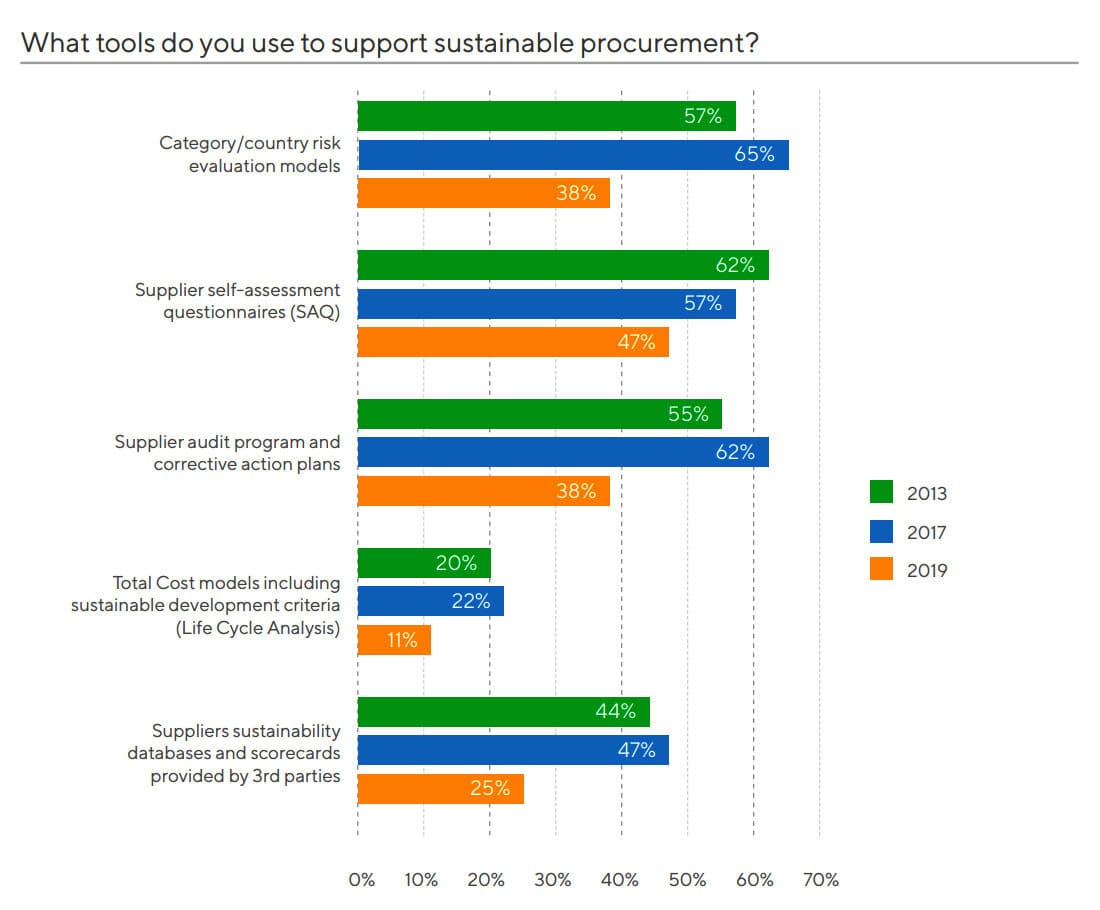
There is obviously a significant need for more visibility to reduce vulnerability and this of course requires better tools, policies and program sophistication. In terms of specific tool adoption, the most widely used mechanism among the survey respondents is a supplier self-assessment questionnaire (47 percent), followed by supplier audit program with corrective action plans and category/country risk evaluation model (both at 38 percent). Supplier sustainability databases and third-party scorecards are used by a quarter of respondents (25 percent).
However, when tool adoption is examined against a benchmark of “sustainable procurement Leaders”, they are shown to go beyond self-assessment questionnaires to third-party rating assessments using databases and scorecards to validate efforts and focus on performance improvement across various sustainability themes.
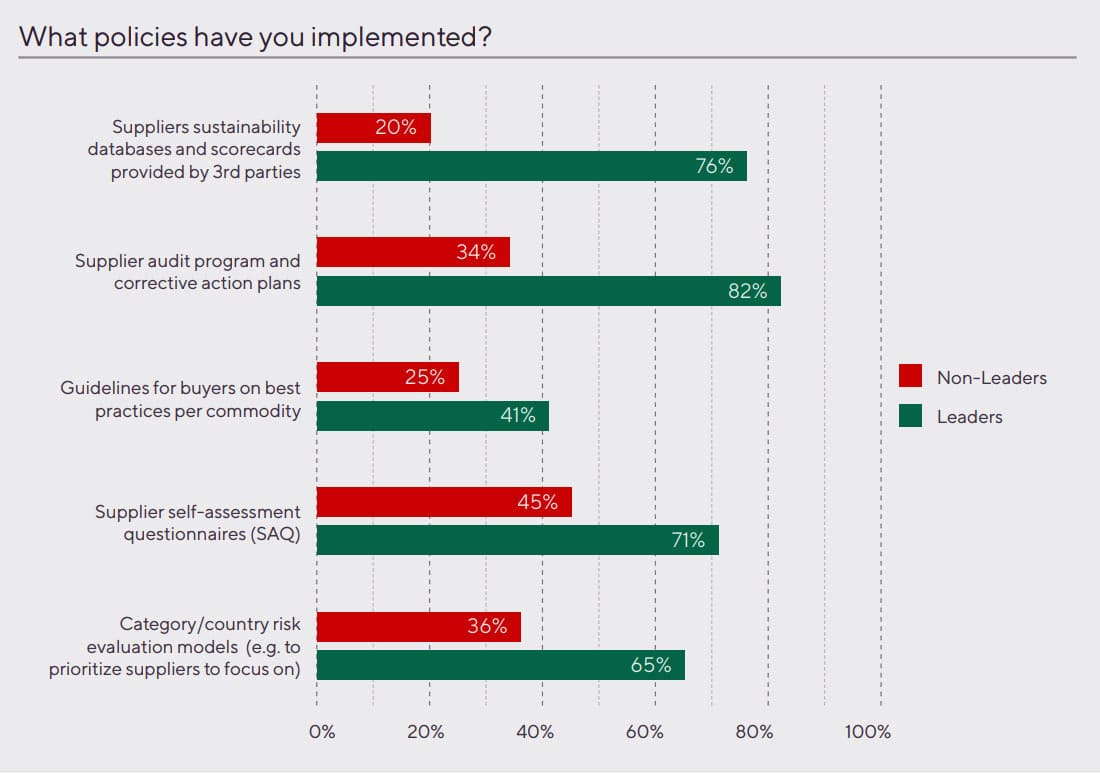
The report shows that these “Leaders” are companies with mature programs, who reported more benefits across the board – risk mitigation (88%), cost savings (35%), innovation (29%) and improved procurement metrics (53%).
When thinking about your organization’s supplier tier visibility, it’s valuable to start with understanding what’s motivating their engagement in sustainability programs and their perception of sustainability commitment. In EcoVadis’ supplier-side survey of the Barometer, for example, nearly half of the companies (43 percent) said their commitment to sustainability is part of their mission and they engage in sustainability in order to improve the world and their community. Only 16% said it was for compliance with regulations. If suppliers are more motivated to engage in sustainability initiatives, collaboration and visibility will be easier to achieve. Also, assessing how suppliers are incentivised to participate in sustainability programs will also help gauge what kinds of work needs to be done to improve. In EcoVadis’ survey, only 18% of suppliers were “very incentivized” to be sustainable and social responsible.
The Compliance Trap
One of the primary hindrances to sustainable procurement programs that drive better overall business performance is what experts are seeing as a “compliance trap.” In other words, organizations are only investing in sustainable procurement to the point of ticking the boxes of regulatory compliance, then stopping. Given the growing stringency in the regulatory landscape, this isn’t necessarily a bad thing, but for procurement teams to see the full value of their programs, along with showing results that spur additional investment, moving beyond compliance is key.
The compliance mindset is also limiting in the fact that it stops short of supplier collaboration. Instead of helping suppliers embrace long-term improvement that could lead to better ROI and uncover new streams of product or process innovation, the compliance traps only encourages performance of the lowest acceptable level.
This year’s Barometer report supports the compliance trap hypothesis based on the sustainability leadership analysis and comparison, which shows that those with more well-developed programs harvest greater value from their sustainable procurement initiatives. Additionally, the supplier study portion of the report shows that 39 of suppliers see their customer’s sustainability commitment “only on paper.” Driving innovation through sustainability means, going beyond the compliance mindset and integrating sustainability performance deep into procurement practices. In terms of how well companies are doing this, the report asked respondents about how they use performance data with suppliers: 51% take sustainability performance into consideration when selecting new suppliers and renewing contracts with existing ones and 39 percent include sustainability criteria in RFP/RFX and tender processes.
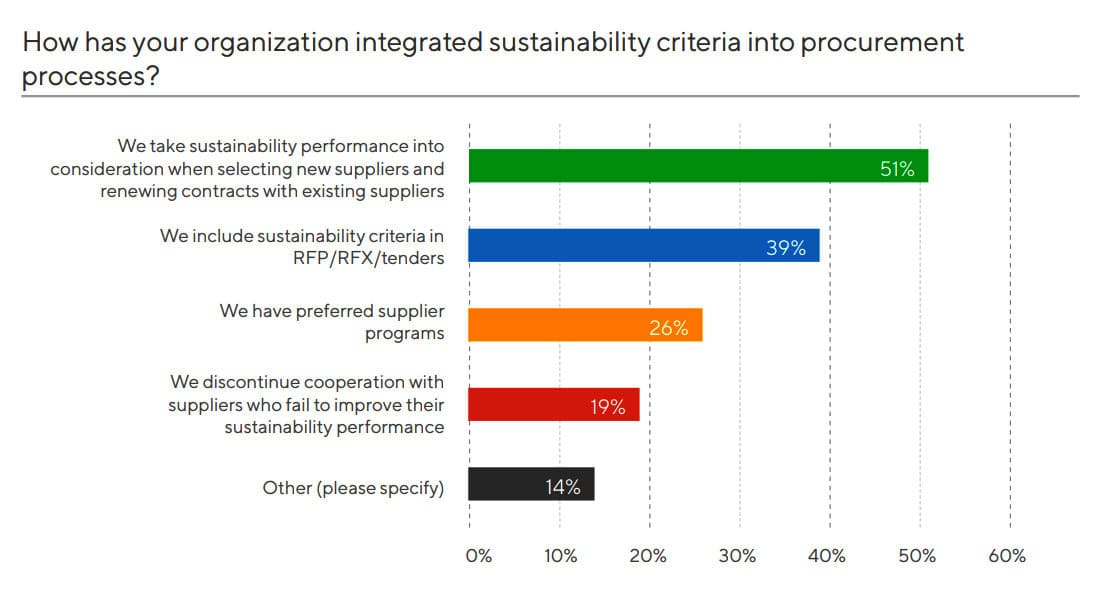
Understanding if you’re in a compliance trap - and how to avoid getting stuck in one - takes an honest assessment of what’s motivating the investment in sustainability and the metrics associated with success. By incorporating a ROI mindset with regard to sustainable procurement initiatives, organizations can continue to push themselves to see greater value from their programs.
Return on Sustainability Investment (ROSI)
In terms of results and benefits from sustainable procurement investments, more than half of this year’s Barometer respondents (58%) say they are better able to mitigate risks thanks to their sustainable procurement program, and 30% have been able to save costs. A quarter of respondents found that their sustainable procurement programs contributed to innovation and enabled access to new categories and price premiums from differentiation. A similar proportion of respondents said they benefited by way of improved procurement metrics and increased sales revenue
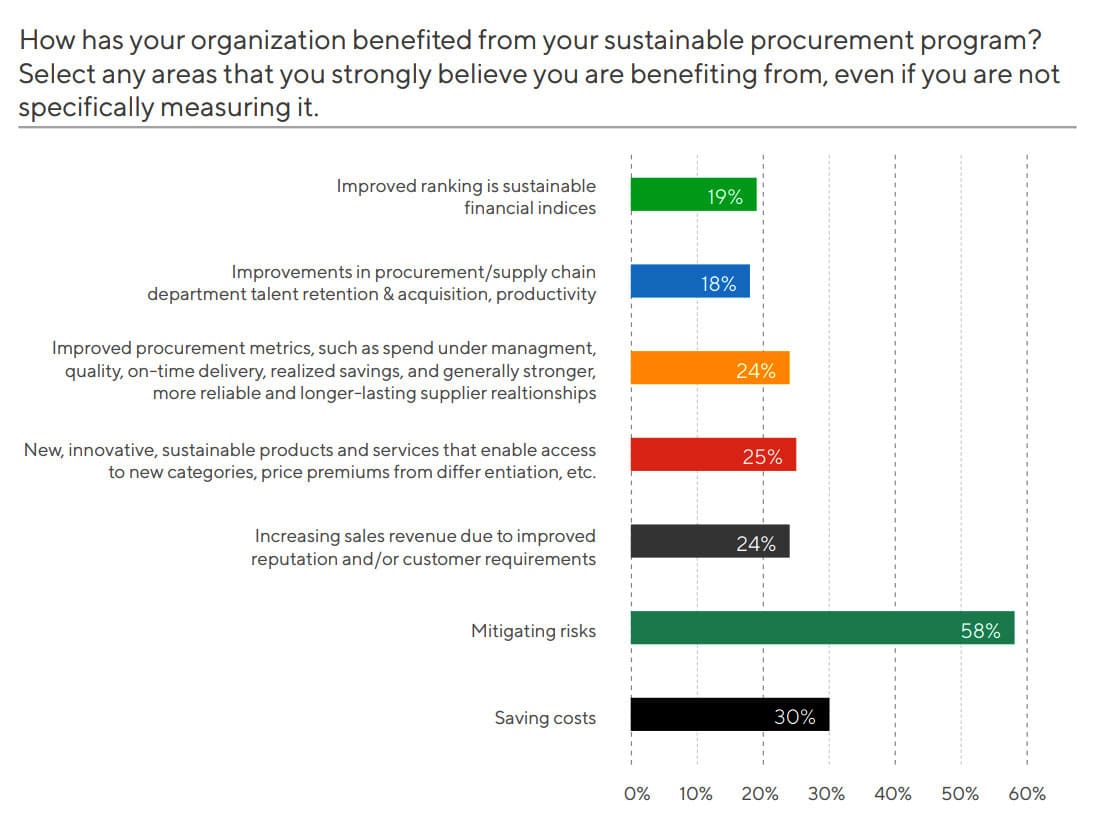
These types of results show significant positive business impact to comprehensive sustainable procurement programs, but in addition to these results, The NYU Stern Center for Sustainable Business has developed the ROSI model to put sustainable procurement results in the same terms as financial measures, enabling CFOs and other company leadership to understand and report on company results stemming from ESG/sustainability programs.
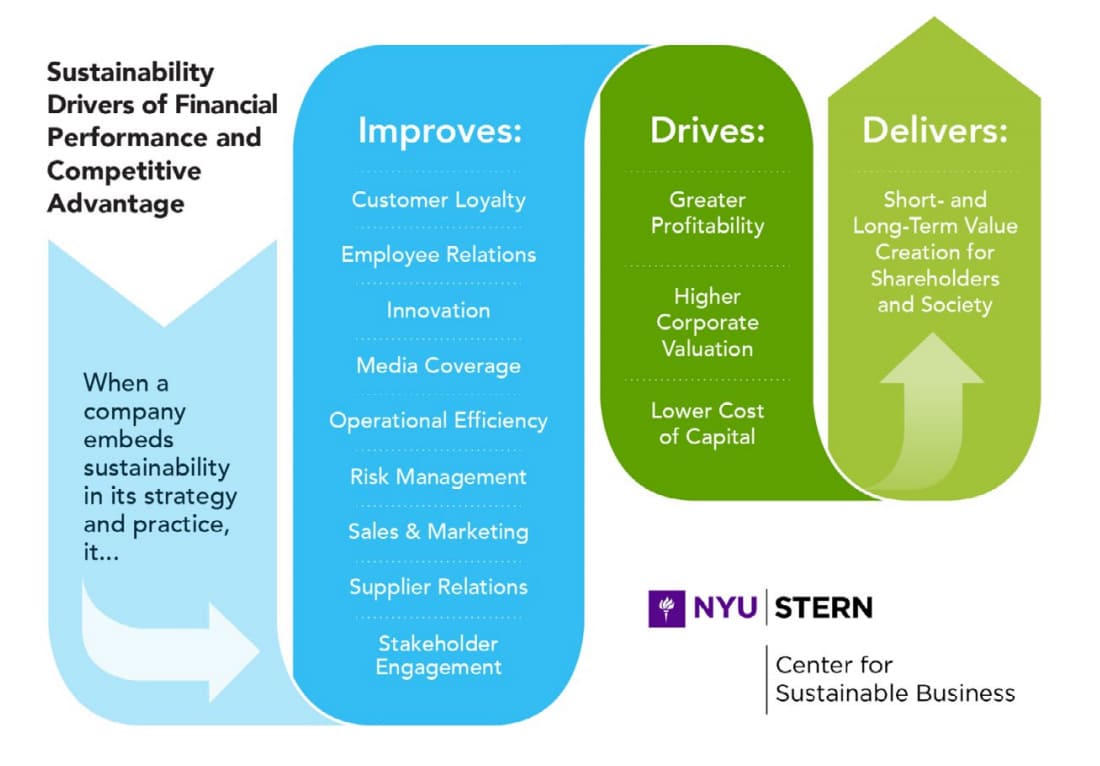
Sustainable procurement is evolving and advancing, not just for better business impact but for a better world. As more organizations begin and mature on their sustainability journey, the greater value will be seen throughout industries. The next step for procurement innovators will be to step out of the compliance mindset and embrace the full value potential of sustainability programs, using more sophisticated process and tools and developing collaborative, performance-oriented relationships with supplier bases. As we look towards the future, the steps taken now will help organizations move toward monetizing their sustainability work and positioning procurement teams as innovation centers - far above and beyond cost savers.
Read and download the full 2019 Sustainable Procurement Barometer report for additional insights, observations and trends.
|
Pierre-Francois Thaler is Co-founder and Co-CEO of EcoVadis, a supplier rating company that helps organizations institute corporate social responsibility (CSR) and various sustainability programs. Pierre brings over 15 years of experience in procurement and developing innovative sourcing solutions. Prior to starting EcoVadis, Pierre was CEO of B2Build SA the first B2B marketplace for the European construction industry, and also served as a director of Ariba’s Procurement BPO business. |
|
About EcoVadis EcoVadis is the world's most trusted provider of business sustainability ratings, intelligence and collaborative performance improvement tools for global supply chains. Backed by a powerful technology platform and a global team of domain experts, EcoVadis' easy-to-use and actionable sustainability scorecards provide detailed insight into environmental, social and ethical risks across 198 purchasing categories and 155 countries. |
Related Insights:
View All
Get more stories like this
Subscirbe for more news,updates and insights from Beroe






